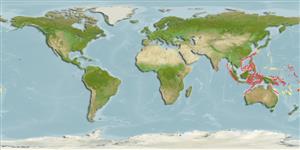分類 / Names
俗名 | 同種異名 | Catalog of Fishes(屬, 種) | ITIS | CoL | WoRMS | Cloffa
Teleostei >
Pleuronectiformes (Flatfishes)
鰈形目 (Flatfishes) >
Paralichthyidae (Large-tooth flounders)
牙鮃科 (Large-tooth flounders)
Etymology: Pseudorhombus: Greek, pseudes = false + Greek, rhombos = paralelogram (Ref. 45335).
More on author: Fowler.
Environment: milieu / climate zone / depth range / distribution range
生態學
海洋 深海底的; 深度上下限 200 - 270 m (Ref. 9494). 深水域
Western Central Pacific: Philippines, Indonesia and Australia.
中西太平洋: 菲律賓,印尼與澳洲。
大小 / 重量 / 年齡
Maturity: Lm ? range ? - ? cm
Max length : 22.0 cm SL 雄魚/尚未辨別雌雄; (Ref. 311)
背棘 (總數) : 0; 背的軟條 (總數) : 67 - 70; 臀棘: 0; 臀鰭軟條: 50 - 53. Color of preserved specimens tan to dark grey on the ocular side; tan or whitish on the blind side. Pectoral fin rays 11-13 on ocular side; 11-12 on blind side. Pelvic fin of ocular side with black spot and shorter than that on the blind side. Gill rakers elongate and pointed. 1st interhemal spine stout.
保存的標本的顏色黃褐色的到深灰色的在有眼睛的一邊上; 黃褐色或微白色的在沒有眼睛的一邊上。 在有眼睛的一邊上的胸鰭鰭條 11-13; 11-12 在沒有眼睛的一邊上。 眼睛側邊的腹鰭有黑色的斑點與短於那在沒有眼睛的一邊上。 鰓耙延長與尖的。 第一 interhemal 棘矮胖的。
Inhabits mud and sand bottoms (Ref. 9774). Feeds on crustaceans and other benthic invertebrates (Ref. 9774).
棲息於泥與沙底部。 (參考文獻 9774) 吃甲殼動物與其他的底棲無脊椎動物。 (參考文獻 9774)
Life cycle and mating behavior
Maturities | 繁殖 | Spawnings | Egg(s) | Fecundities | 仔魚
Distinct pairing (Ref. 205).中西太平洋: 菲律賓,印尼與澳洲。
Hensley, D.A. and K. Amaoka, 1989. A redescription of Pseudorhombus megalops, with comments on Cephalopsetta ventrocellata (Osteichthyes: Pleuronectiformes: Paralichthyidae). Proc. Biol. Soc. Wash. 102(3):577-585. (Ref. 2688)
IUCN 瀕危狀態 (Ref. 130435)
無危 (LC) ; Date assessed: 13 November 2019
人類使用
工具
特別的報告
下載 XML
網路資源
Estimates based on models
Preferred temperature (Ref.
123201): 11.7 - 20.8, mean 15 °C (based on 37 cells).
Phylogenetic diversity index (Ref.
82804): PD
50 = 0.5000 [Uniqueness, from 0.5 = low to 2.0 = high].
Bayesian length-weight: a=0.00741 (0.00343 - 0.01604), b=3.17 (3.00 - 3.34), in cm total length, based on LWR estimates for this Genus-body shape (Ref.
93245).
營養階層 (Ref.
69278): 3.5 ±0.44 se; based on food items.
回復力 (Ref.
120179): 高度, 族群倍增時間少於 15個月 (Preliminary K or Fecundity.).
Fishing Vulnerability (Ref.
59153): Low vulnerability (17 of 100).
